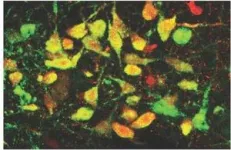(Press-News.org) Even in tech-heavy Washington state, the numbers of students with access to computer science classes aren’t higher than national averages: In the 2022-2023 school year, 48% of public high schools offered foundational CS classes and 5% of middle school and high school students took such classes.
Those numbers have inched up, but historically marginalized populations are still less likely to attend schools teaching computer science, and certain groups — such as Latinx students and young women — are less likely than their peers to be enrolled in the classes even if the school offers them.
To reach a greater diversity of grade-school students, University of Washington researchers taught a group of high schoolers to code by combining cultural research into various embroidery traditions — such as Mexican, Arab and Japanese — with “computational embroidery.” The method lets users encode embroidery patterns on a computer through an open-source coding language called Turtlestitch, in which they fit visual blocks together. An electronic embroidery machine then stitches the patterns into fabric.
The team will publish its findings Mar. 22 in Proceedings of the 55th ACM Technical Symposium on Computer Science Education.
“We’ve come a long way as a country in offering some computer science courses in schools,” said co-lead author F. Megumi Kivuva, a UW doctoral student in the Information School. “But we’re learning that access doesn’t necessarily mean equity. It doesn’t mean underrepresented minority groups are always getting the opportunity to learn. And sometimes all it means is that if there’s one 20-student CS class, all 3,000 students at the school count as having ‘access.’ Our computational embroidery class was really a way to engage diverse groups of students and show that their identities have a place in the classroom.”
In designing the course, the researchers aimed to make coding accessible to a demographically diverse group of 12 students. To make space for them to explore their curiosities, the team used a method called “co-construction” where the students had a say each week in what they learned and how they’d be assessed.
“We wanted to dispel the myth that a coder is someone sitting in a corner, not being very social, typing on their computer,” Kivuva said.
Before delving into Turtlestitch, students spent a week exploring cultural traditions in embroidery — whether those connected to their own cultures or those they were curious about. For one student, bringing his identity into the work meant taking inspiration from his Mexican heritage; for others, it meant embroidering an image of bubble tea because it’s her favorite drink, or stitching a corgi.
Students also spent a week learning to embroider by hand. The craft is an easy fit for coding because both rely on structures of repetition. But embroidery is tactile, so students were able to see their code move from the screen into the physical world. They were also able to augment what they coded with hand stitching, letting them distinguish what the human and the machine were good at. For instance, one student decided to code the design for a flower, then add a bee by hand.
“There’s a long history of overlooking crafts that have traditionally been perceived as feminized,” said co-lead author Jayne Everson, a UW doctoral student in the Paul G. Allen School of Computer Science & Engineering. “So combining this overlooked art that is deeply technical with computing was really fun, because I don’t see computing as more or less technical than embroidery.”
The class ran for six weeks over the summer, and researchers were impressed by the interest it elicited. In fact, one of the main drawbacks researchers found was that six weeks felt too short, given the curiosity the students showed. Since the technology is affordable — the embroidery machine is $400 and the software is free — Kivuva plans to tailor the course to be approachable for kindergarteners to 5th-grade refugee students. Since they were so pleased with the high student engagement, Kivuva and Everson will also run a workshop on their method at the Computer Science Teachers Association conference this summer.
“I was constantly blown away by the way students were engaging when they were given freedom. Some were staying after class to keep working,” said Everson. “I come from a math and science teaching background. To get students to stick around after class is kind of like, ‘Alright, we’ve done it. That’s all I want.’”
Additional co-authors on the paper were Camilo Montes De Haro, a UW undergraduate researcher in the iSchool, and Amy J. Ko, a UW professor in the iSchool. This research was funded by the National Science Foundation, Micorosoft, Adobe and Google.
For more information, contact Kivuva at megumik@uw.edu and Everson at everjay@uw.edu.
END
UW researchers taught kids to code with cultural research and embroidery machines
2024-03-14
ELSE PRESS RELEASES FROM THIS DATE:
Association for Psychological Science offers new training opportunities to its members with Instats partnership
2024-03-14
(WASHINGTON, D.C.) — The Association for Psychological Science (APS), the leading organization serving psychological researchers, practitioners, teachers, and students from around the world, has announced a new partnership that will expand the training and career development resources available to its members.
APS has partnered with Instats, a virtual learning platform offering live and on-demand research training seminars, courses, and workshops. Instats provides its PhD-level programming through its global network of ...
FRYL gene variants linked to a new neurological disorder
2024-03-14
A recent study from the lab of Dr. Hugo J. Bellen, distinguished service professor at Baylor College of Medicine and investigator at the Jan and Dan Duncan Neurological Research Institute (Duncan NRI) links the FRYL gene to a new neurodevelopmental disorder in humans. They used fruit flies to establish that the loss of a functional copy of the FRY-like transcription coactivator (FRYL) gene is the underlying cause of this new disorder in fourteen individuals. The study was published in the American Journal of Human Genetics.
FRYL ...
Age and sex associated with patient’s likelihood of antimicrobial resistance
2024-03-14
A person’s age, sex and location are correlated with the chance that they have a bloodstream infection that is resistant to antibiotics, according to a new study published March 14th in PLOS Medicine by Gwenan Knight of the London School of Hygiene and Tropical Medicine, UK, and colleagues.
Antimicrobial resistance (AMR), in which infections cannot be treated with antibiotics, is a major global public health threat. Little has been known about how the prevalence of resistance varies with age and sex even though antibiotic usage, changes in immune function, and exposure to high-risk settings are all linked to age and sex.
In the new study, researchers analyzed ...
Coronavirus envelope protein is a drug target for new platform for the identification and optimization of peptides against SARS-CoV-2
2024-03-14
Coronavirus envelope protein is a drug target for new platform for the identification and optimization of peptides against SARS-CoV-2
#####
In your coverage, please use this URL to provide access to the freely available paper in PLOS Biology: http://journals.plos.org/plosbiology/article?id=10.1371/journal.pbio.3002522
Article Title: Developing inhibitory peptides against SARS-CoV-2 envelope protein
Author Countries: United States
Funding: This work was supported by Columbia University Dean’s ...
How fear unfolds inside our brains
2024-03-14
Our nervous systems are naturally wired to sense fear. Whether prompted by the eerie noises we hear alone in the dark or the approaching growl of a threatening animal, our fear response is a survival mechanism that tells us to remain alert and avoid dangerous situations.
But if fear arises in the absence of tangible threats, it can be harmful to our well-being. Those who have suffered episodes of severe or life-threatening stress can later experience intense feelings of fear, even during situations that lack a real threat. Experiencing this generalization of fear is psychologically damaging and can result in debilitating long-term mental health conditions ...
A new world of 2D material is opening up
2024-03-14
Materials that are incredibly thin, only a few atoms thick, exhibit unique properties that make them appealing for energy storage, catalysis and water purification. Researchers at Linköping University, Sweden, have now developed a method that enables the synthesis of hundreds of new 2D materials. Their study has been published in the journal Science.
Since the discovery of graphene, the field of research in extremely thin materials, so-called 2D materials, has increased exponentially. The reason is that 2D materials have a large surface area in relation to their volume or weight. This ...
Discovered: Cellulose-degrading gut bacteria in the human gut, although at lower levels in industrialized countries
2024-03-14
Previously undescribed human gut bacteria that aid in the digestion of plant cellulose are scarce in urban societies but abundant in ancient and hunter-gatherer microbiomes, according to a new study. The findings provide insight into the poorly understood cellulosome-producing bacteria that inhabit the human gut and their response to modern urban diets and lifestyles. Like all mammals, humans rely on the gut microbiome to digest cellulose – the main component of plant fiber and a common element in diets that include plant-based material. Fermentation of dietary fiber via cellulosome-producing ...
Direct-to-consumer microbiome testing lacks regulation and clinical validity
2024-03-14
In a Policy Forum, Diane Hoffman and colleagues argue that direct-to-consumer (DTC) microbiome tests lack analytical and clinical validity and require more federal regulation to prevent consumer harm. A growing body of research has suggested the potential for improving human health by better understanding the microbiome, leading to the emergence of a global industry selling DTC microbiome services. However, despite its impact on the lifestyle health and wellness market, regulation of the DTC microbiome testing industry has been virtually ignored. According to Hoffman et al., these companies’ claims of having ...
New approach to plastic production, under more sustainable conditions
2024-03-14
Researchers have developed a more sustainable method to do the work required to make plastics that are comparable to widely used low-density polyethylene (LDPE) plastics. They say their method is industrially viable. LDPE is a soft, flexible, and lightweight plastic material that is widely used in a variety of commercial applications, including plastic films, bottles and other pliable products. LDPE’s unique properties are derived from its tree-branch-like molecular structure, bestowing flexibility. The material is also ductile due to its lower crystallinity. These properties set it apart from other, more linear varieties of polyethylene. ...
A telluride-free way to improve the performance of thermoelectric systems
2024-03-14
Researchers report they have boosted the performance of a thermoelectric device using an approach that doesn’t require tellurium. The findings reveal a path toward more efficient and sustainable commercial applications of thermoelectric cooling based on Earth-abundant compounds. Efficient and sustainable cooling is crucial to modern living, particularly in our warming world. However, current cooling strategies require substantial energy, which can exacerbate anthropogenic climate impacts. Thermoelectric cooling is an attractive solid-state heat-pump technology that could reduce energy consumption ...






